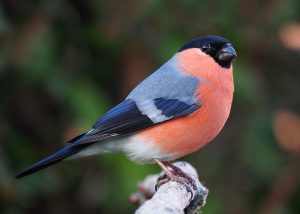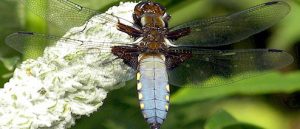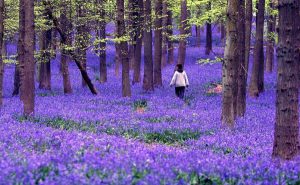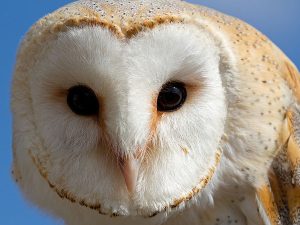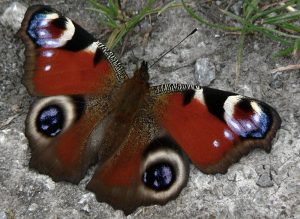The beginning of March is always a really exciting time in my garden as there are changes almost daily especially in the day length. One thing I look forward to with great anticipation is a warmish night as I know that it will bring all the male Frogs out of their hiding places around the garden, to take up territory in the Marshy Pond. We have several ponds in the garden here, of varying sizes and depths and each has its own special assortment of wildlife. Frogs favour the Marshy Pond which is fairly small and in places quite shallow, which means that it warms up more quickly in Spring than the Big Pond which is deep and cool. Next month our toads and newts will return to the Big Pond, but frog spawning begins here in earnest in late February or early March depending on the weather conditions. I always know when they have arrived. When I step outside, somewhere in the background is a low throaty rumble and as I approach the pond this grows into a deep ‘churring’ noise and there will be plenty of splashing about going on as the males chase each other around. Last year the Marshy Pond seemed full to capacity with dozens of frogs and the whole surface was a mass of spawn after just a couple of nights. So this year it hasn’t surprised me to see frogs hopping from the smaller pond – which seems to be standing room only at the moment – across to the larger one. In doing this though they are exposing themselves to a certain amount of danger – in fact I witnessed one being eaten by a buzzard which must have noticed the activity from the wood next door and dropped down into the garden for an easy meal. Over in the Big Pond there are now several males, bobbing and diving if I approach, but no spawn as yet. I’m wondering if these are young males from last year that have been ousted from the more favourable, warmer water of the Marshy Pond to find their own spawning space. I look forward to the outcome of this amphibian activity.

I opened my back door out to the garden the other morning to hear the most wonderful sound – the song of a Mistle Thrush singing from a tree nearby. This is a species that occasionally visits the garden here for fallen apples in autumn and winter, but if this thrush – a larger and more upright version of a song thrush – visits a garden at all, it is more likely his choice rather than anything to do with our wildlife gardening efforts. They are very much countryside birds and it is not easy to attract this species to your garden. They may visit gardens in the late autumn and winter for food in the form of berries, and those of the rowan, if you have one, are especially favoured. Cotoneaster and holly berries are also sought out by this large thrush but for most of the year they forage on the ground for large invertebrates including slugs and worms. So can we tempt this lovely bird, with his gorgeous speckled breast and lilting song, to our gardens in any other way? Well it really is about getting the habitat in our gardens right which means natural food, some trees or dense shrubs and a nice place from which to sing. Mistle thrushes, like song thrushes, love to declare their territorial presence from the top of a tree as early as December – they are often amongst the first birds to start singing as the days to lengthen. This wonderful bird has nested in my garden just once – quite low down in the branches of an apple tree not far from my back door. All grass mowing had to stop until nest building and egg laying, followed by avid feeding of the four youngsters, was compete. It was wonderful to see the young birds around the garden for some time after they had fledged, following their parents and begging for food until they learned to find their own. Since then they have not nested in the garden again but young birds have been seen and males sing from trees around us, suggesting they nest nearby. A mistle thrush in your garden is something exciting and to hear one singing on a spring morning is really special.

The flowers of the Dandelion look garish when compared to the subtle yellow of the primrose this month, but the dandelion is one of the most important plants in our gardens, and in the past was an important plant in the country calendar. The leaves of dandelion are edible (but disgustingly bitter!) but for many country folk in the past these leaves represented a welcome fresh vegetable at the end of a long hard winter. They were eaten as a tonic, supplying vitamins and minerals, especially potassium. Many of the country names for this plant include the word clock (a dandelion clock is still a favourite play thing for many children – and also for me for that matter) but the old Somerset name ‘wet-a-bed’ and many other even ruder signatures for this plant remind us of what we were all told as children – that picking dandelions makes you wet the bed! The French colloquial name ‘pis-en-lit’ confirms that this was a commonly held idea in Europe too. And there is a reason for this. Dandelion leaves contain a diuretic, so their reputation as a tonic was well founded – eating the leaves will flush toxins from the kidneys, and possibly the bed wetting idea arose from this property too. The leaves are now often to be found amongst mixed salads in restaurants and the flowers, which are also edible, impart a touch of honeyed sweetness to a dish. The common name, dandelion, comes from the French ‘dent de lion’, meaning lion’s tooth, and describes the jagged edge of the leaf. Modern herbalists use this plant to treat gall bladder and liver ailments and the roots can be roasted to produce a coffee substitute. But what about this humble little ‘weed’ in our gardens? This month it will be bursting into flower and its bright yellow tousled heads will be the first flowers that peacock, small tortoiseshell and brimstone butterflies head for. It is one of the most important plants we can grow in a wildlife garden for butterflies, bees and finches which eat the seeds. As gardeners we all need to learn to love our dandelions.

March is just about my last chance to have any sort of short holiday before my wildlife garden takes up all my spare time until late September, and I take the opportunity to get away while I can. So last week I drove up to Anglesey for a few days in the hope of seeing some exciting wildlife and I was certainly rewarded. It helped that the weather was glorious – clear and sunny although rather cold – so a couple of trips to well known wildlife watching spots were definitely called for. Around the place where I was staying is a good population of red squirrels in the woods which are managed for wildlife, so I was able to watch and photograph the squirrels every morning which was a joy, but my trip up to the RSPB reserve at South Stack on the north-west of the island was the highlight of my few days. On arrival, almost as soon as I stepped out of the car, I was met by the sight of a pod of more than twenty dolphins cruising past and heading around the lighthouse point, some leaping out of the waves as though they were thoroughly enjoying the lovely weather! But the highlight for me was the sight of a pair of Choughs, one of my favourite birds, chasing each other around in the windy sky and flying with the great skill and grace that these birds always display. That would have been good enough for me but next I spotted a male peregrine falcon on the cliffs, in a place close to where there has been a nest in previous years and had wonderful views of him sitting and circling, and generally giving the thousands of guillemots and razorbills on the cliffs below a bit of a fright. There were no puffins here at this time but they were expected any day. Before heading off a cup of coffee was needed, and the delight of the day was a chough (above) sitting happily on a fence post right outside the RSPB cafe, which meant I was able to get close-up views and photographs of this extraordinary bird without being blown off a cliff top! These intelligent birds nest successfully close by and are well known to the staff there.

Just as the first swallow is an iconic symbol of the arrival of summer, for me a buzzing Queen Bumblebee lumbering about low in the garden must be one of the first proper signs of spring. The lazy drone of these huge, furry insects as they search my garden for a place to start a nest is always a thrill to hear in March. I find them irresistible and generally end up rushing about madly, following them around with my camera, in an effort to get a photograph of one emerging from her chosen nest site. I did just this yesterday but only managed to get a quick, blurred photo as my bumblebee left the potential nest hole – which was obviously not suitable – before moving on to investigate the next. Her behaviour was typical of a queen bumble searching for a home. She flew around the garden very low to the ground, zig-zagging almost methodically back and forth across the lawn, the meadows and the border areas. Every time she came across an entrance to a nest which had been occupied last year by a wood mouse or bank or field vole which we have here in abundance, she hovered around it for a while and then disappeared inside, remaining underground for some time. Presumably she spent this time checking it for its suitability as a nest site although we can only guess at her reasons for rejecting it. On one occasion she carefully entered a hole, and then emerged about thirty seconds later from another hole several meters away! Obviously this was an underground run rather than a former nest, and therefore not suitable for her purposes so she continued her search until I lost sight of her. Queen bumblebees detect small mammal nests by sense of smell and once she has found an abandoned nest the queen will then do some rearranging of any existing dry grass in the hole, sometimes adding a little of her own nesting material, before she gets down to the business of producing her bumblebee colony. It is always a privilege to have a bumblebee nest here but it is also an excuse to observe the fascinating behaviour of these wonderful insects.

In the last few weeks there has been an influx of Siskins into our garden. Most years we see some at the end of the winter (if indeed it is the end) with the bright yellow, black-capped males and the pretty, streaky yellow and cream females feeding all around the garden on any available seed feeders. They especially like nyjer seed and will fight with the larger goldfinches for this commodity but once they are used to using the bird feeders here they seem interested in most small seeds including sunflower hearts. They will also feed on peanuts, sneaking in between the larger birds such as greenfinches and woodpeckers as long is there is space. At first glance this little finch looks a little like a mini greenfinch, but in fact is much more delicate in build with much streakier plumage and a finely pointed beak – perfect for extracting the seeds from small tree cones. Siskins and greenfinches do however share a very aggressive nature and once they have found a food source the siskins will fight off much bigger species to keep the seeds to themselves. Here we are very lucky to hear the occasional male singing as the spring progresses, usually from near the top of one of our trees or from the large hazel right outside our kitchen window, but so far they seem uninterested in the alders that I planted especially for them when we first moved here! Alder cones provide an important natural food source for them and as they are quite acrobatic birds it is a delight to watch them up in the tops of alder trees, twittering, feeding and quite often fighting. I suspect our alders may still be too small to be producing seed but all our feeders and the ground beneath the hanging feeders where seed has spilled, currently host these beautiful little birds. Best of all, they visit a little bird food tray which is just outside the back door, affording me intimate views and the opportunity to photograph these very special little finches close up.



